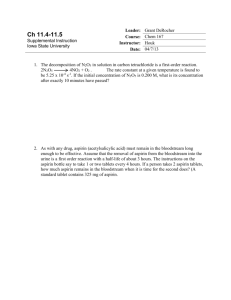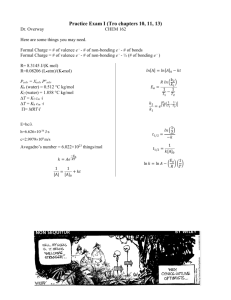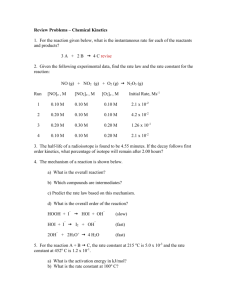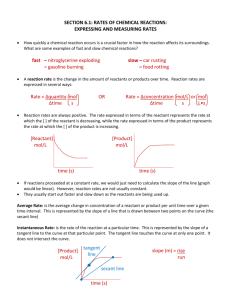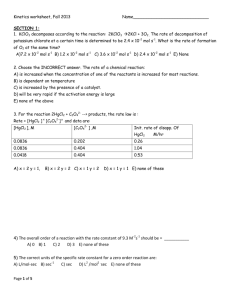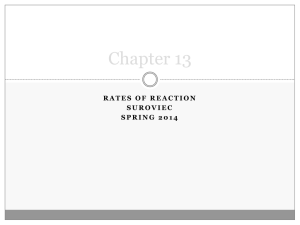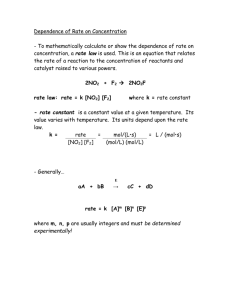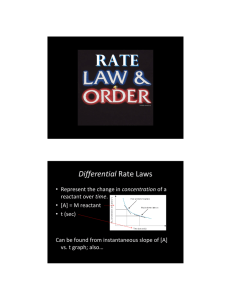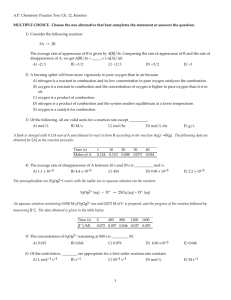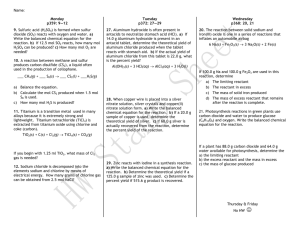Kinetics Homework
advertisement
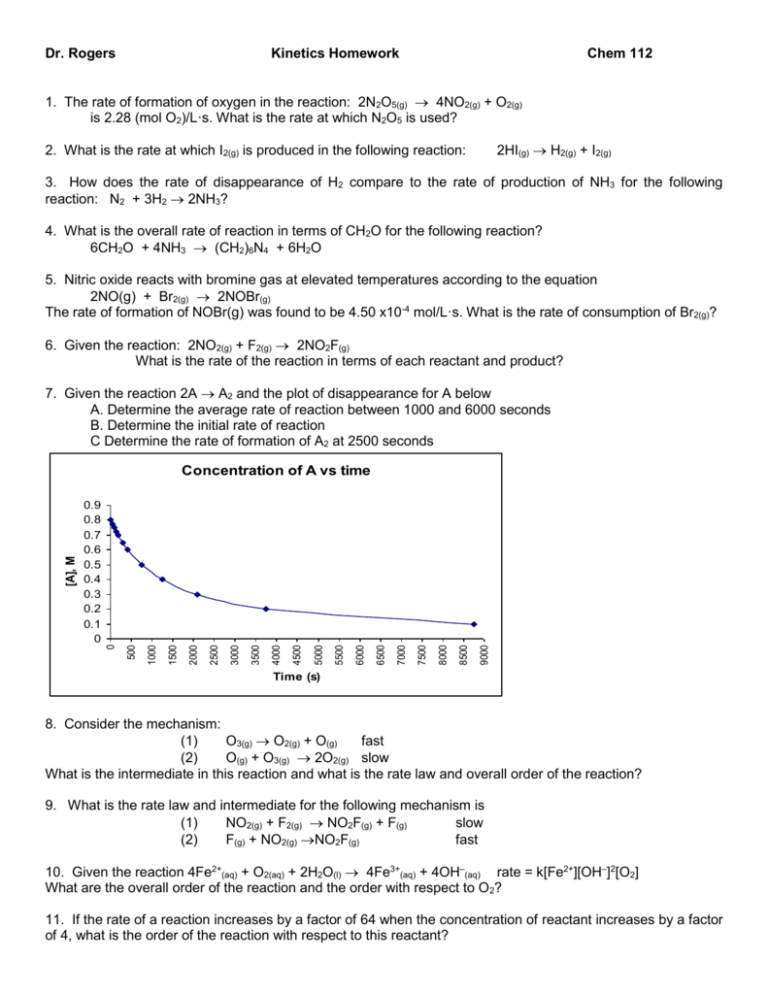
Dr. Rogers Kinetics Homework Chem 112 1. The rate of formation of oxygen in the reaction: 2N2O5(g) 4NO2(g) + O2(g) is 2.28 (mol O2)/L·s. What is the rate at which N2O5 is used? 2HI(g) H2(g) + I2(g) 2. What is the rate at which I2(g) is produced in the following reaction: 3. How does the rate of disappearance of H2 compare to the rate of production of NH3 for the following reaction: N2 + 3H2 2NH3? 4. What is the overall rate of reaction in terms of CH2O for the following reaction? 6CH2O + 4NH3 (CH2)6N4 + 6H2O 5. Nitric oxide reacts with bromine gas at elevated temperatures according to the equation 2NO(g) + Br2(g) 2NOBr(g) The rate of formation of NOBr(g) was found to be 4.50 x10-4 mol/L·s. What is the rate of consumption of Br2(g)? 6. Given the reaction: 2NO2(g) + F2(g) 2NO2F(g) What is the rate of the reaction in terms of each reactant and product? 7. Given the reaction 2A A2 and the plot of disappearance for A below A. Determine the average rate of reaction between 1000 and 6000 seconds B. Determine the initial rate of reaction C Determine the rate of formation of A2 at 2500 seconds 9000 8500 8000 7500 7000 6500 6000 5500 5000 4500 4000 3500 3000 2500 2000 1500 1000 500 0.9 0.8 0.7 0.6 0.5 0.4 0.3 0.2 0.1 0 0 [A], M Concentration of A vs time Time (s) 8. Consider the mechanism: (1) O3(g) O2(g) + O(g) fast (2) O(g) + O3(g) 2O2(g) slow What is the intermediate in this reaction and what is the rate law and overall order of the reaction? 9. What is the rate law and intermediate for the following mechanism is (1) NO2(g) + F2(g) NO2F(g) + F(g) slow (2) F(g) + NO2(g) NO2F(g) fast 10. Given the reaction 4Fe2+(aq) + O2(aq) + 2H2O(l) 4Fe3+(aq) + 4OH–(aq) rate = k[Fe2+][OH–]2[O2] What are the overall order of the reaction and the order with respect to O2? 11. If the rate of a reaction increases by a factor of 64 when the concentration of reactant increases by a factor of 4, what is the order of the reaction with respect to this reactant? 12. What is the overall order of the decomposition of ozone that has the rate law Rate = k[O3]2[O2]–1 13. For the reaction: 2A + B products write the rate expression for this reaction and the rate constant with proper units given the following data: Initial Concentration, M Initial Rate, M·s–1 A B 0.10 0.10 2.0 x10–2 0.20 0.10 8.0 x 10–2 0.30 0.10 1.8 x 10–1 0.20 0.20 8.0 x 10–2 0.30 0.30 1.8 x 10–1 14. The data below was obtained in a study on how the rate of a reaction was affected by the concentration of the reactants. From the following data write the rate law for this reaction and give the value for k with proper units. Experiment 1 2 3 4 5 [A], M 0.200 0.200 0.600 0.200 0.200 [B], M 0.100 0.400 0.100 0.100 0.200 [C], M 0.600 0.400 0.200 0.200 0.400 Rate, mol/L·s 5.00 80.0 15.0 5.00 20.0 15. The following data are obtained for the initial rates of reaction in the reaction: A + 2B + C 2D + E Experiment [A], M [B], M [C], M 1 1.4 1.4 1.00 2 0.70 1.40 1.00 3 0.70 0.70 1.00 4 1.40 1.40 0.50 5 0.70 0.70 0.5 A. What is the order of reaction with respect to A, B, C and overall? B. What is the value of R5 in terms of R1? Initial rate R1 R2 = ½ R1 R3 = ¼ R2 R4 = 16 R3 R5 16. The half-life of a chemical reaction was found to be independent of the amount of material the researcher employed. What order is this reaction? Concentration of Theophylline (mg) 17. The following graph was obtained for the release of a sustained-release tablet of Theophylline. A. What is the order of the reaction? Amount of Theopylline remaining in a B. What is the rate constant of this reaction including 300 mg sustained-release dosage form units as a function of time C. how long will it take to release half of the drug? D. How long will it take to release 90 % of the drug? y = -24.672x + 299.61 350 R2 = 0.9988 300 250 200 150 100 50 0 0 5 10 15 Time (hours) 18. What is the order of the reaction and rate law for the following experimental data? Time(hr) Conc (M) Time(hr) Conc (M) Time(hr) Conc (M) 0.0 7.95x 10-2 3.0 6.38 x 10-2 8.00 4.0 x 10-2 -2 -2 1.0 7.4 x 10 6.0 4.85x 10 10.00 2.95 x 10-2 Time(hr) 12.00 14.00 Conc (M) 1.95 x10-2 9.5 x 10-3 19. For the following graphs give the order and the integrated rate law (A) (B) [H O ] ti me 1 [H O ] (C) ti me ln[H 2O2] time 20. You are traveling up I-95 at a constant speed of 70 miles/hour How long will it take to drive 643 miles? 21. For the reaction: C2H6(g) 2CH3(g) rate = k[C2H6] If k = 5.50 x 10–4 s–1 and [C2H6]initial = 0.0200 M, calculate the rate of reaction after 1 hour. 22. Given: 4PH3(g) P4(g) + 6H2(g) rate = k[PH3] –1 If the rate constant is 0.0278 s , calculate the percent of the original PH3 which has reacted after 76.0 s. 23. Consider the following reaction: 2N2O(g) 2N2(g) + O2(g) rate = k[N2O] For an initial concentration of N2O of 0.50 M, calculate the concentration of N2O remaining after 2.0 min if k = 3.4 x10–3 s–1. 24. A first-order reaction has a rate constant of 0.00300 s–1. What is the time required for 75.0 % of the reaction to complete? 25. Consider the following reaction: 2N2O5(g) 4NO2(g) + O2(g) rate = k[N2O5] Calculate the time for the concentration of N2O5 to fall to ¼ its initial value if the k = 5.20 x 10–3 s–1. 26. Given: SO2Cl2(g) SO2(g) + Cl2(g) rate = k[SO2Cl2] If 70.0% of the SO2Cl2 has reacted after 80.0 s, calculate the rate constant. 27. A. What is the initial rate of reaction for the following data? B. What is the average rate of reaction from 10 to 25 seconds? C. What is the order and the rate constant of the reaction with the following data for the disappearance of A at 25°C: [A], M Time, s [A], M Time (s) 0.090 0 0.032 20 0.069 5 0.025 25 0.054 10 0.019 30 0.042 15 28. The following data were obtained for the disappearance of A at 44.3°C: [A], M Time (s) [A], M Time (s) 0.568 30 0.257 320 0.509 70 0.193 420 0.443 120 0.127 570 0.337 220 Determine A) the order of this reaction B) calculate the rate constant and C) calculate the half-life. 29. The isotope I-131 has a half-life of 8.05 days. What fraction of the initial concentration of iodine-131 remains after 3 weeks? The decay of I-131 is first-order. 30. A second-order reaction has a rate constant of 1.25 M–1·s–1. If the initial reactant concentration is 1.0 M, calculate the time required for 90.0% reaction. 31. Consider the dimerization reaction below: 2A A2 rate = k[A]2 When the initial concentration of A is 2.0 M, it requires 1 hour for 60% of A to react. Calculate the rate constant at these conditions. 32. Consider the dimerization of butadiene: 2C4H6(g) C8H12(g) rate = k[C4H6]2 –1 –1 If the rate constant is 0.014 M ·s , calculate the time required for dimerization of 90% of the butadiene for an initial concentration of butadiene of 0.10 M. 33. Consider the following reaction:2NO2(g) 2NO(g) + O2(g) rate = k[NO2]2 When the initial concentration of NO2 is 100 mM, it takes 74 s for 80% of the NO2 to react. Calculate the rate constant. 34. Consider the following reaction: NOBr(g) NO(g) + 1/2Br2(g) A plot of [NOBr]–1 versus time gives a straight line with a slope of 2.00 M–1·s–1. what is the order of the reaction and the rate constant? 35. A reaction has k = 8.39 M–1·s–1. How long does it take for the reactant concentration to drop from 0.0420 M to 0.0110 M? 36. The rate law for the reaction: A + B C + D is first order in [A] and second order in [B]. If [A] is halved and [B] is doubled, What will happen to the rate of the reaction ? 37. If a reaction proceeding by the mechanism: A+BC+D occurs at a rate x, and if the concentrations of A and B are both doubled, what will be the new rate of reaction? 38. The addition of a catalyst in a chemical reaction (A) increases the concentration of products at equilibrium. (B) increases the fraction of reactant molecules with a given kinetic energy. (C) provides an alternate path with a different activation energy. (D) lowers the enthalpy change in the overall reaction. no catalyst present 39. Which statement concerning the reaction coordinate diagram is true? (A) (B) (C) (D) The catalyst decreases the activation energy. The reaction is endothermic. The addition of a catalyst slows this reaction. A and B have lower potential energy than C and D. catalyst present A+ B C+ D reaction coordinate 40. For the following graph label points A, C and D. A E D B reaction coordinate C 41. Calculate the activation energy for a reaction with the following data: T, °C k, s–1 25 5.8 33 16 38 27 43 47 . 42. A certain reaction has a rate constant of 0.0503 s–1 at 298 K and 6.71 s–1 at 333 K. What is the activation energy for this reaction? 43. Calculate the rate constant at 43°C for the reaction: (NH3)5CoNC–R3+(aq) + OH–(aq) (NH3)5CoNHCOR2+(aq) if k = 5.8 x106 M–1·s–1 at 25°C and Ea = 92 kJ/mol. Answers: 1. 4.56 (mol N2O5)/L·s 2. I2(g)]/t 3. The rate of disappearance of H2 is 3/2 the rate of appearance of NH3 4. –[CH2O]/6t 5. 2.25 x 10-4 mol/L·s 6. rate of rxn = –[F2]/t = –[NO2]/2t = [NO2F]/2t 7. a. 2.5 x 10-5 mol/L s -4 -5 b. 7.0 x 10 mol/L s c. 3.58 x 10 mol/L s (Remember these are from a graph. Your number may be slightly different.) 8. Rate = k[O][O3]; overall order= 2 intermediate = O 9. rate = k[NO2][F2]; intermediate = F 10. 4 and 1 11. 3 12. 1 13. rate = (2.0 L/mol·s)*[A]2 2 0 3 2 2 14. rate = k[A][B] [C] k=2.5 x 10 L /mol s 15. A 1; B 2; C –1; overall 2: R5 = R1/4 16. first 17. A) zero B) 24.67 mg/hr C) 6.1 hr D) 10.9 hr 18. zero ; k = 0.005 M/hr 19. A) zero [A]t = [A]o – kt; B) second (1/[A]t) = (1/[A]o) + kt; C) first ln [A]t = ln[A]o – kt 20. 9.19 hours 21. 1.52 x 10–6 M/s 22. 87.9% 23. 0.33 M 24. 462 s –1 25. 267 s 26. 0.0150 s 27. First. k = 0.0516 s-1 -1 28. A) first; B) .0026 s ; C 248 s 29. 0.164 30. 7.2 s 31. 2.1 x10–4 M–1·s–1 32. 6400 s 33. 0.54 M–1·s–1 –1 –1 34. second: 2.00 M ·s 35. 8.00 s 36. be increased by a factor of 2. 37. 4x 38. C 39. A 40. A) Ea of forward reaction; C) H D) Ea of reverse reaction 41. 1.0 x103 J/mol 42. 115 kJ/mol 43. 4.8 x 107 M–1·s–1
